 You will need a good sized baking dish (corningware works the best if you have one. Otherwise, any solid ceramic dish should be fine). Put it either on top of a biscuit tray, or sit it inside a larger baking dish. This is to catch drips because, if you're anything like me, you're going to fill that dish right up. Give the baking dish a good spray with some oil to stop the lasagne from sticking.
You will need a good sized baking dish (corningware works the best if you have one. Otherwise, any solid ceramic dish should be fine). Put it either on top of a biscuit tray, or sit it inside a larger baking dish. This is to catch drips because, if you're anything like me, you're going to fill that dish right up. Give the baking dish a good spray with some oil to stop the lasagne from sticking. Fresh lasagne sheets. I really can't recommend using anything other than these. If you do feel the need to use dry sheets, then
Fresh lasagne sheets. I really can't recommend using anything other than these. If you do feel the need to use dry sheets, then  There's a knack to getting these lasagne sheets unstuck from each other without tearing them. Place the whole lot down on your board, and open each sheet as though it's a page in a delicate book. Start at the top corner, and run your hand gently down the length, before peeling it back.
There's a knack to getting these lasagne sheets unstuck from each other without tearing them. Place the whole lot down on your board, and open each sheet as though it's a page in a delicate book. Start at the top corner, and run your hand gently down the length, before peeling it back.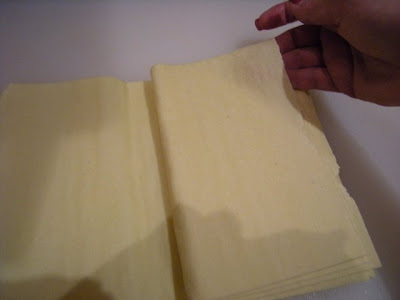 Rinse and repeat.
Rinse and repeat. And then on to the other side.
And then on to the other side. It should now be pretty trivial to pull each sheet off the pile as you go.
It should now be pretty trivial to pull each sheet off the pile as you go.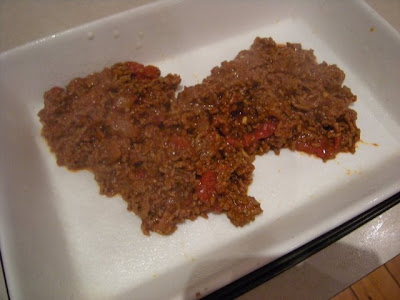 Put a third of the mince in the bottom of the dish.
Put a third of the mince in the bottom of the dish. It should just cover the entire base. Feel free to use a little extra here if you need it. Use your spoon to push it right into the corners.
It should just cover the entire base. Feel free to use a little extra here if you need it. Use your spoon to push it right into the corners. Put a sheet of lasagne on top, and use your set square to work out how how to fill up the rest.
Put a sheet of lasagne on top, and use your set square to work out how how to fill up the rest. Cut out any bits you need.
Cut out any bits you need. And then place them on top too. Try not to overlap them too much, but it's important not to leave gaps.
And then place them on top too. Try not to overlap them too much, but it's important not to leave gaps. Dribble a third of the bechamel over the top of the pasta. See how the corners are starting to curl up a little? That's because of the heat in the meat.
Dribble a third of the bechamel over the top of the pasta. See how the corners are starting to curl up a little? That's because of the heat in the meat.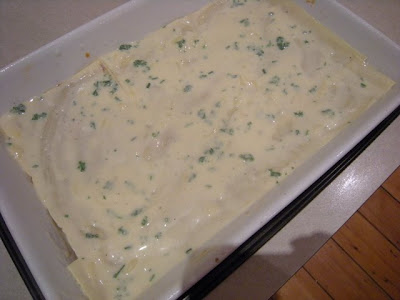 Smear the bechamel all around, and push those curly edges back down. Make sure you don't leave any holes.
Smear the bechamel all around, and push those curly edges back down. Make sure you don't leave any holes. Sprinkle some grated cheese over the sauce.
Sprinkle some grated cheese over the sauce. And add another layer of pasta.
And add another layer of pasta. Now for the second lot of meat.
Now for the second lot of meat.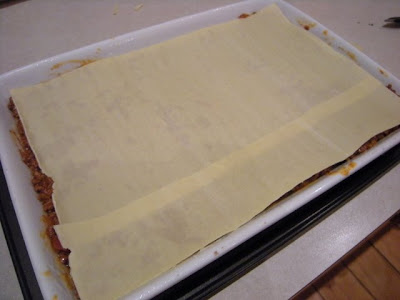 Another layer of pasta.
Another layer of pasta. Some more bechamel and cheese. Top this with another layer of pasta.
Some more bechamel and cheese. Top this with another layer of pasta. Then put the last of the meat on. Don't stress if this layer is a bit short, just smear it around as evenly as you can. Top it with another sheet of pasta.
Then put the last of the meat on. Don't stress if this layer is a bit short, just smear it around as evenly as you can. Top it with another sheet of pasta.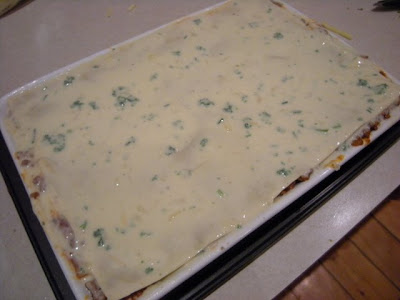 Then drizzle the rest of the bechamel over the top. Don't put a layer of pasta on top of this one, though. If you have any lasagne sheets left, put them in a snap-lock bag and store them in the freezer. You can thaw them out on the bench and use them next time. Alternatively, you can slice them up into thin pieces, and use them as fettucine.
Then drizzle the rest of the bechamel over the top. Don't put a layer of pasta on top of this one, though. If you have any lasagne sheets left, put them in a snap-lock bag and store them in the freezer. You can thaw them out on the bench and use them next time. Alternatively, you can slice them up into thin pieces, and use them as fettucine. Whatever you do, don't use pre-grated cheese for the top of the lasagne. It never melts properly. Get out whatever hard tasty cheese you have in the fridge (low fat is good, so that you don't end up swimming in oil. I've used Colby here, though, as it's what I had).
Whatever you do, don't use pre-grated cheese for the top of the lasagne. It never melts properly. Get out whatever hard tasty cheese you have in the fridge (low fat is good, so that you don't end up swimming in oil. I've used Colby here, though, as it's what I had). Be liberal, and completely cover the bechamel sauce with the grated cheese.
Be liberal, and completely cover the bechamel sauce with the grated cheese. Sprinkle some more parsley on for some colour. You can also use cracked pepper, paprika, or just about any fresh herb here.
Sprinkle some more parsley on for some colour. You can also use cracked pepper, paprika, or just about any fresh herb here. Very loosely put some foil over the top. If you put it on too tightly, then the cheese will end up sticking to the foil, and not on the top of the lasagne where we want it. Pop it in the oven at 180 degrees.
Very loosely put some foil over the top. If you put it on too tightly, then the cheese will end up sticking to the foil, and not on the top of the lasagne where we want it. Pop it in the oven at 180 degrees. After 45 minutes to an hour, pull it out of the oven, and take the foil off. See the puddles of oil I have here? That's because I used full-fat cheese on the top. You can use a paper towel to blot that off. Put it back in topless. Put the garlic bread in with it.
After 45 minutes to an hour, pull it out of the oven, and take the foil off. See the puddles of oil I have here? That's because I used full-fat cheese on the top. You can use a paper towel to blot that off. Put it back in topless. Put the garlic bread in with it. And after another thirty minutes ... it's ready!
And after another thirty minutes ... it's ready! The garlic bread should be nice and brown now too.
The garlic bread should be nice and brown now too. Pull open the foil and put it on the table.
Pull open the foil and put it on the table. And serve up the lasagne. Stand back and watch people make fools of themselves as they scramble for the plates.
And serve up the lasagne. Stand back and watch people make fools of themselves as they scramble for the plates.Any leftovers? Put the individual pieces in plastic containers and freeze for up to three months.
0 comments:
Post a Comment